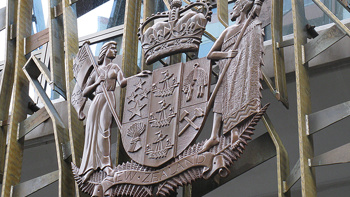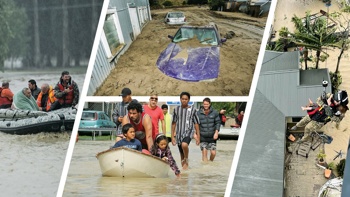New data showing that more than 43,000 Aucklanders are directly threatened by rising seas has prompted warnings that home insurers may be forced in future to hike prices - or withdraw coverage altogether.
An Auckland Council report gauged the region's exposure to varying scenarios of climate change-driven sea level rise – notably the 25cm projected for 2045, 50cm by 2060, 1m by 2100, 2m by 2160 and up to 3m beyond next century.
Already, between 1.5 per cent and 4.5 per cent of the city's land area now sat in low-lying coastal areas that could be vulnerable.
And the report found how, over the past decade, the population boomed in those areas vulnerable to sea level rise more than in the region overall, now leaving about three per cent of Aucklanders exposed.
That equated to about 43,000 people - up from 34,700 people in 2001.
By the end of the century, the report warned, up to 2.5 per cent of the Auckland region might be affected, with a further 3.7 per cent at risk being swamped by inundation from storm surge, high tides and large waves.
It wasn't just peoples' homes in the firing line: up to six per cent of council-owned greenspaces were threatened - including 55 cemeteries – as were three per cent of buildings and dozens of public facilities.
One Civil Defence building was exposed to two metres of sea level rise, while another building at Middlemore Hospital sat within the three-metre band.
While less than two per cent of Auckland's CBD was at risk of what is projected for this century, the affected area jumped to 30 per cent with the 2m predicted for next century.
On top of that, about one per cent of roads in the region were threatened by a sea level one metre higher – and some areas of Auckland International Airport were affected under every scenario, as was one wastewater treatment plant and pipes and manholes across the city.
/arc-anglerfish-syd-prod-nzme.s3.amazonaws.com/public/XZK47D4WCZAZNIAHYH4ITKUQ4A.jpg?width=527&height=674&mode=max)
This graphic shows localised sea level rise projections over different time scales. Source / Auckland Council
The picture was also dire for rural coastal areas – and there was a risk that five per cent of the region's most fertile land could be at risk as early as the middle of the century.
There were further obvious threats to many coastal ecosystems, and mangroves, which have ironically long offered protection against the sea, were singled out as the worst affected.
It was a taste of what faced the rest of New Zealand, and which the insurance industry was acutely aware of.
As house insurance was typically offered out 12 months ahead, the effects of climate change, 20 years down the track, weren't being signalled today, Insurance Council chief executive Tim Grafton said.
"What we can say is that if we ignore sea-level rise and permit more and more property to be at risk from climate change, then there will inevitably be a day when losses due to sea-level rise, storm surges and flooding become more and more frequent," he said.
"If we continue to do nothing, then insurers will respond by deciding whether they want to accept those risks and if they do, they will price to reflect the higher risk or increase the levels of excess or the initial amount an insured will have to pay when losses occur."
Grafton said the sector was a strong advocate for society taking a long view of climate change risks and applying a risk framework, much like insurers long had.
"That means we need to assess the risk to people and their property, calculate the probable losses, make decisions about what level of risk we are prepared to tolerate," he said.
"We then need to assess what risks we will retain, what risks we can viably reduce and what risks we want to transfer to others, like insurers. By doing this, we can assess the full impact of climate change."
Auckland Council's chief sustainability officer, John Mauro, said planning and consideration of sea level rise in Auckland had been happening for some time, from the development controls in the Auckland Unitary Plan to the SH16 causeway upgrade.
"The stark reality of new and emerging evidence around sea level rise suggests that our ambitions and preparedness need to rise as well."
While council departments were working together under a new resilience-based programme, Mauro said gaps remained, and a regional climate action plan would help address these.
The new report was released alongside several others, one of which found Auckland's poorest would be hardest hit by an equivalent three months of extra-hot days projected for within only a century's time.
/arc-anglerfish-syd-prod-nzme.s3.amazonaws.com/public/C6ZQS7K53NHUDBWUD5RKPONTDA.jpg)
About one per cent of Auckland's roads are threatened by seas projected to be a metre higher by the end of the century. Photo / File
Earlier this year, councils lobby Local Government New Zealand revealed $14b of ratepayer-owned infrastructure was at risk of climate change and called for national adaptation fund, a new risk agency and a state-led review to give councils more clarity.
The Government was already developing a new "risk assessment system" to help communities prepare and give guidance on how financial costs should be shared.
By the numbers
50cm of sea level rise projected by 2060, along with 1m by 2100, 2m by 2160 and up to 3m beyond next century.
1.5%-4.5% of Auckland's land area sits in low-lying coastal areas that could be exposed to sea level rise ranging from 0.25m to 3m.
43,300 Aucklanders currently directly at risk from future sea level rise, up from 34,700 people in 2001.
Take your Radio, Podcasts and Music with you









